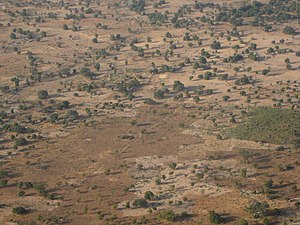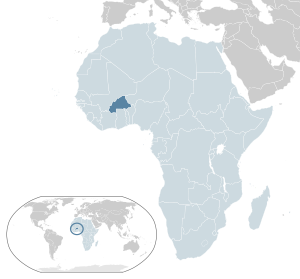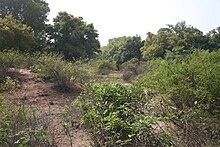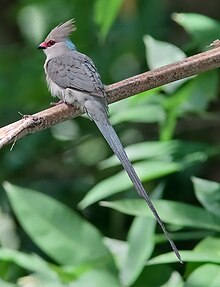Wildlife of Burkina Faso
Burkina Faso is largely wild bush country with a mixture of grass and small trees in varying proportions.
Fauna, one of the most diverse in West Africa, includes the elephant, hippopotamus, buffalo, monkey, lions, crocodile, giraffe, various types of antelope, and a vast variety of bird and insect life.
The dominant habitat types are the grassy savanna in the north with transition to the varying thin forests in the south.
During the rainy season is when the shrubs and stunted trees flourish in the savanna in the northern region where rainfall incidence is about 10 inches and the rivers flow full with dense vegetation growing in the southern region of the country when the rainfall incidence is as high as 40 inches (1,000 mm).
It borders with Benin (the Pendjari River forms the boundary) and Singou Game Ranch on its northwest direction and has large network of drainage system which has vast flood plains.
Within the park boundary, the Falaise de Gobnangou is a prominent hill feature with cliffs that extends over 50 kilometres (31 mi) from the southwest to the northeast.
Shrub and tree-savanna (extensive growth of Isoberlinia doka) in the non-flooded areas, Mitragyna inermis with gallery forests in seasonally flooded areas, baobab Adansonia digitata trees near old village sites are some of the vegetation types found in the park.
[5] The Deux Balés National Park, is located in central eastern Burkina Faso, within Mouhoun Province.
[8] In 2001, the largest number of elephants in West Africa were found in Deux Balés (together with Baporo Forest), estimated at four hundred of them.
The park has varied topography with geological formations of granite outcrops, lateritic plateaus and several isolated high mountains.
Until 2008, the implementation of a regional management was supported by the EU-funded Project ECOPAS (French: Ecosystèmes Protégés en Afrique Soudano-Sahélienne).
In the three nations, the park covers about 10,000 km2 (3,900 sq mi), largely uninhabited by humans, having been until the 1970s a malarial zone of wetlands formed by the delta of the Mékrou River with the Niger, broken by rocky hills.
[citation needed] The common chimpanzee is considered locally extinct in Burkina Faso, but may be migrating back into the country during the rainy season.
These cover species under several families such as: thirteen of Anatidae, one of Numididae (helmeted guineafowl Numida meleagris), six of Phasianidae, one of Podicipedidae, two of Ciconiidae, one of Anhingidae (African darter Anhinga rufa), one of Pelecanidae (great white pelican Pelecanus onocrotalus), one of Scopidae (hamerkop Scopus umbretta), seventeen of Ardeidae, five of Threskiornithidae, one of family Pandionidae (osprey Pandion haliaetus), thirty-nine of Accipitridae (mostly eagles, vultures and hawks), one of Sagittariidae (secretary-bird Sagittarius serpentarius), eleven of Falconidae, nine of Rallidae, one of Rallidae (African finfoot Podica senegalensis), six of Otididae, one of Gruidae (black crowned-crane Balearica pavonina), three of Burhinidae, eleven of Charadriidae, two of Recurvirostridae, two of Jacanidae, eighteen of Scolopacidae, two of Turnicidae, five of Glareolidae, one of Rostratulidae (Greater painted-snipe Rostratula benghalensis), eight of Laridae, two of Pteroclidae, thirteen of Columbidae, two of Psittacidae, two of Musophagidae, twelve of Cuculidae (cuckoos), one of Tytonidae (barn owl Tyto alba), eight of Strigidae, eight of Apodidae, one of Coliidae (blue-naped mousebird Urocolius macrourus), one of Trogonidae (Narina trogon Apaloderma narina), nine of Alcedinidae, eight of Meropidae, five of Coraciidae, one of Upupidae (Eurasian hoopoe Upupa epops, two of Phoeniculidae, four of Bucerotidae, four of Lybiidae, two of Indicatoridae, two of Indicatoridae, nine of Picidae, three of Platysteiridae, two of Prionopidae, nine of Malaconotidae, two of Campephagidae, nine of Laniidae, two of Oriolidae, three of Dicruridae, two of Monarchidae, three of Corvidae, one of Nicatoridae (western nicator Nicator chloris, nine of Alaudidae, seventeen of Hirundinidae, one of Stenostiridae (African blue-flycatcher Elminia longicauda), one of Paridae (white-shouldered black-tit Parus guineensis), two of Remizidae, one of Certhiidae (spotted creeper Salpornis salvadori), two of Pycnonotidae, four of Phylloscopidae, six of Acrocephalidae, twenty of Cisticolidae, one of Hyliotidae (yellow-bellied hyliota Hyliota flavigaster), twenty-seven species of Muscicapidae, three of Turdidae, three of Timaliidae, one of Zosteropidae (northern yellow white-eye Zosterops senegalensis), nine of Sturnidae, one of Buphagidae (yellow-billed oxpecker Buphagus africanus), eight of Motacillidae, four of Emberizidae, three of Fringillidae, three of Passeridae, nineteen of Ploceidae, nineteen of Estrildidae and six of Viduidae.
Of the migratory birds, 81 belong to Palaearctic family and two species are of global conservation concern, namely Falco naumanni (vulnerable) and Gallinago media (near threatened).
Northern Burkina Faso consists mainly of savanna, acacia woodland, and during the wet season, prickly shrubs and stunted trees flourish.
[1] Although the shea tree is indigenous to the semi-arid Sahel region of West Africa, Burkina Faso contains the largest number of them.
[19] Between 1982 and 1985, an attempt was made to improve the Bambara groundnut, an initiative which involved the participation of plant breeders in the Grain Legumes Programme.
[10] It was also noted that the natural habitats were found now only in parks, reserves and gazetted forests as agricultural operations dominated the scene in 70% area of the country.
The nearing extinction species were reported to be black and white colobus, dama gazelle, leopard and topi.
This alarming situation of loss of biodiversity resulted in creation of national operational strategies not only for rural development in 2001 but also for reforms in the wildlife and protected area sector in 1995 (a Forestry Code was introduced defining the National Forestry Policy and establishing 12 Wildlife Conservation Units covering the entire country in followed in 1996) and Biodiversity Strategy and Action Plan in 2000 with the objective stated as to "ensure responsible management of biological diversity by the populations by 2025".
However, all these efforts are concentrated at Lake Oursi (included in the List of Ramsar wetlands of international importance) and are yet to permeate to a national scale.







